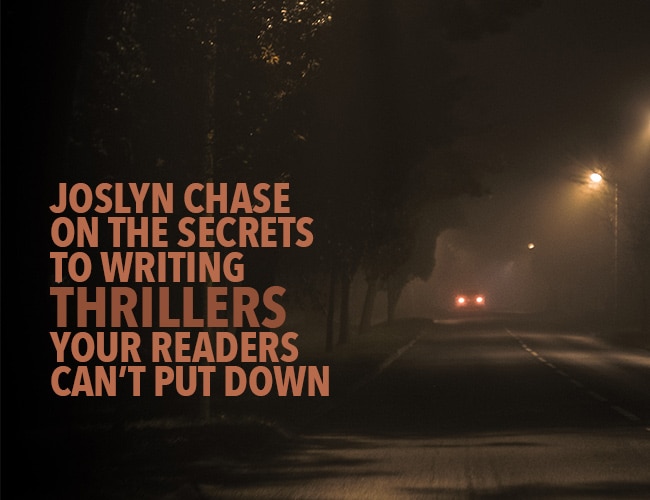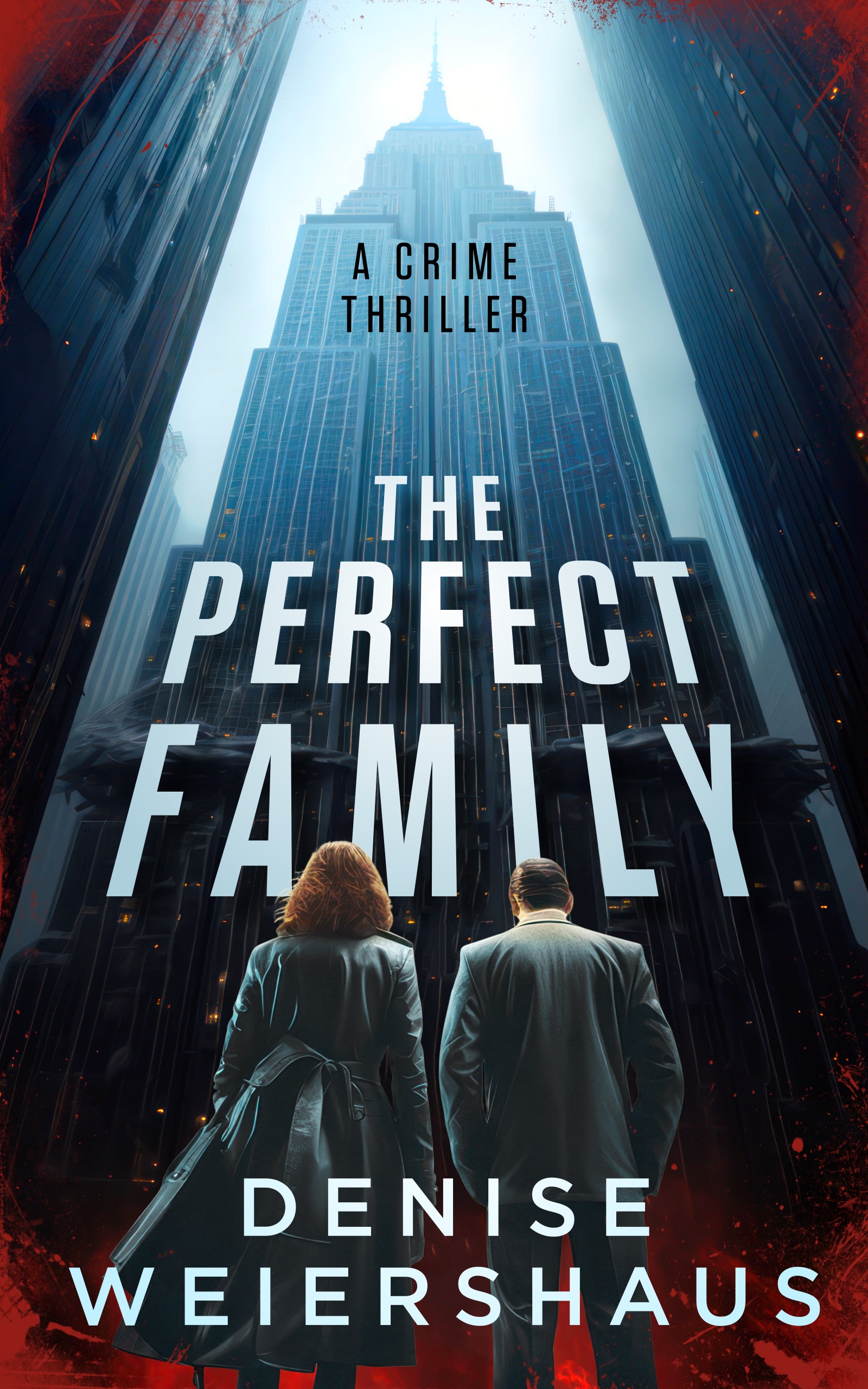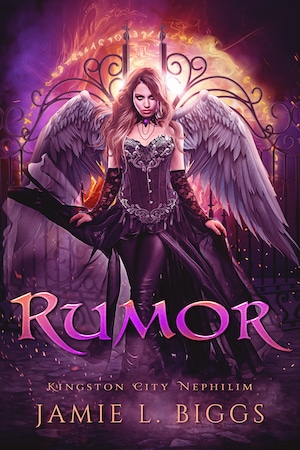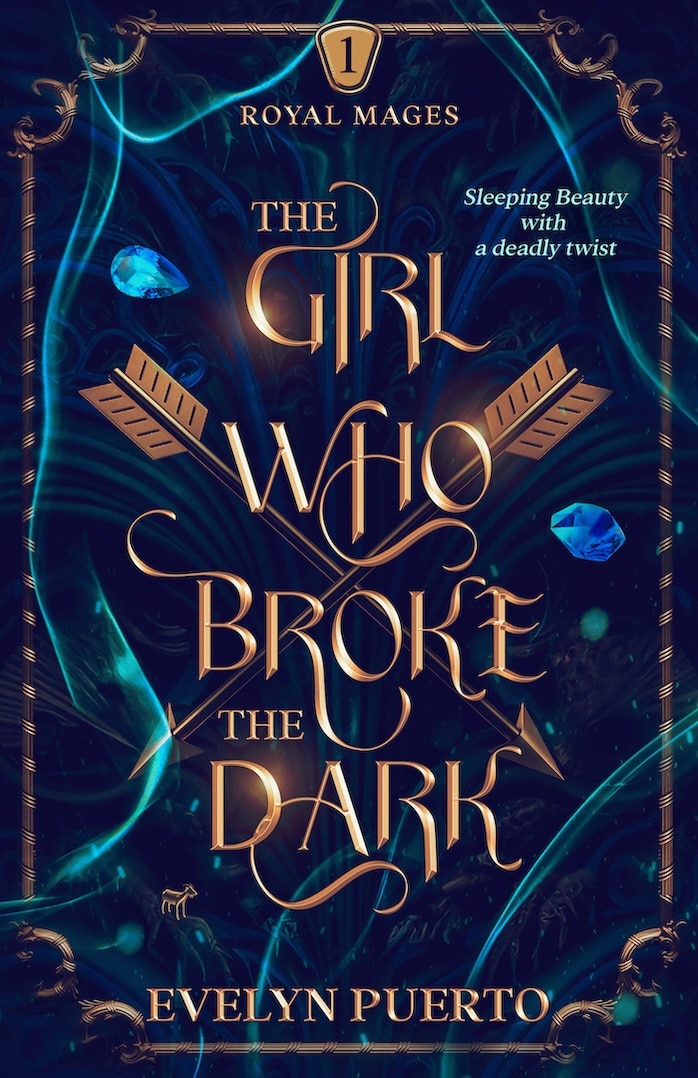Thrillers are hot right now and have been for some time. They can be intimidating to write, however. If you're looking to dive into the thriller game, this month's interviewee has some tips to get you started and keep your readers on their toes.

The Key to Writing Thrillers: Keep Your Readers Engaged
Writing thrillers is tough business. You need to keep your reader engaged while not exhausting them, but also not putting them to sleep. This month's interviewee is one of our own, The Write Practice blog contributor Joslyn Chase. She's here to discuss what makes a great thriller and how to keep your readers turning the pages.
Joslyn is a prize-winning author of mysteries and thrillers. Any day where she can send readers to the edge of their seats, chewing their fingernails to the nub and prickling with suspense is a good day in her book.
Joslyn's love for travel has led her to ride camels through the Nubian desert, fend off monkeys on the Rock of Gibraltar, and hike the Bavarian Alps. But she still believes that sometimes the best adventures come in getting the words on the page and in the thrill of reading a great story.
Joslyn believes in the power of story, and writes a blog on the subject which you can find at joslynchase.com. Join the growing group of readers who’ve discovered the thrill of Chase when you sign up, and get access to updates and bonuses. You can also connect with her on Facebook and check out her book trailers on YouTube.
Meet Joslyn Chase
I’m super excited for this interview, as I’ve been a fan of yours for quite a while. Can you tell me a little about your latest book and what inspired you to write it?
Thank you, Sarah! I’m really happy to be doing this interview. The release for my latest book is just a few days away—November 19—and I’m really excited for people to get it in their hands and start reading.
It’s called Steadman’s Blind, and it’s a paraquel to my 2017 thriller, Nocturne In Ashes. By that, I mean it runs parallel to the story in Nocturne, sharing the same setting but with a unique adventure and told by a different set of characters.
The stories cross over in a few spots, so readers who’ve read one of the books get an extra layer of fun and suspense seeing the scene from a different perspective when they read the sister book.
Both novels are set during the eruption of Mt. Rainier and the aftermath that ensues. In Nocturne, a killer is on the loose in a community trapped by flooding. Cell phones are down and radio reception is patchy, but they manage to get a call through to the local sheriff. However, it takes three days for deputies to arrive.
Steadman’s Blind is the story of those three days from the deputies’ point of view, and I’ll tell you, the road to a crime scene has never been so jagged!
I put together a short documentary, using footage and photography from the book’s setting, telling a little about how the book was born and sharing snippets from some of the chapters. I made this part of the special preorder package readers get when they order Steadman’s Blind by midnight, November 19.
It’s a tremendous deal—they get a free copy of Nocturne In Ashes, access to the documentary video, Steadman’s Blind, and a bonus short story featuring characters from the book. All for only $2.99, when they forward their receipt to joslynchase [at] outlook [dot] com.
And there’s a trailer—check it out!
The Technique of Writing Thrillers
You write thrillers, which is the genre we get questions about all the time. Readers expect a lot out of thrillers: engagement, suspense, twists . . . it seems like a tough genre to write. So let’s talk about the technical side of writing thrillers. What’s the thing you focus on first? Do you make intense outlines, planning out each twist and turn?
I always work from an outline, and to me, that’s where the fun is. It’s like dumping an enormous bucket of Legos on the floor and sitting down beside them to play, putting together different combinations, trying different things, asking “what if” questions and brainstorming dozens of answers.
Then, when I sit down to write, I have a scene-by-scene outline, with a goal for each scene. I don’t always know how I’ll get from Point A to Point B, but I have a fair idea of the ground I’ll need to cover and I let the scene play out in my head until I know I’ve got it.
Then I write what happened, how it felt and sounded and smelt. Sensory detail is very important to me.
And just like you can easily reconfigure a structure made out of Legos, my outline is flexible too. Sometimes things change and that can send a ripple effect through the outline. But I feel like having a master plan ensures I’m spending my time on a story that has a strong foundation and is likely to provide satisfaction for my readers.
How to Pace a Thriller
Pacing is important in all genres, but it’s especially important in thrillers, which can become so high-octane that it exhausts readers. Yet you also don’t want your readers to snooze. Can you give us a general overview of what great pacing looks like and how you go about it?
I’m a music teacher, so I often see parallels between music and writing. When performing a piece of music, dynamics—how loud and soft you play—and tempo—the varying speeds at which you play—are critical. I liken this to tone and pacing, which are inextricably connected, in writing.
Sometimes a student will start a piece too loudly, leaving himself nowhere to go when the music calls for a crescendo. With pacing, there needs to be variety that increases like a good stock portfolio, going up and down on a continuous overall rise to the climax. So hold something in reserve for that ultimate high point, and don’t forget to give your readers a chance to breathe as they climb that slope.
Don’t let the ups and downs fall into a predictable pattern. Change it up, and keep your reader curious and tantalized. Scene and chapter breaks are good places to vary the dynamic, and diverting to a subplot changes the pace, as well.
I personally use what are sometimes called “potato chip” chapters. I like to keep them short and leave readers hungry for more so they’ll reach into the bag and keep munching. Chapter length is another way to add variance.
Two more techniques worth mentioning here are white space and cliffhangers. White space is using the power of the paragraph to create more white space on the page when the tempo is fast. Readers gobble this up and physically have to turn the pages more often, which creates a fast-paced feeling.
And cliffhangers—a good cliffhanger virtually forces a reader to jump to the next chapter, keeping the pace moving along.
I saved the most crucial element for last—suspense. Suspense is an absolute must in every kind of story, but is paramount in thrillers. Readers read to feel something, and suspense is a delicious sensation.
But in order for a reader to feel anything beyond the superficial, they have to care about the characters. That means creating an engaging character before the action goes into full swing.
Then you have to establish a threat or potential danger to the character the reader cares about and spark up a slow burn of worry and suspense as the situation grows more dire. Make sure the outcome is uncertain, that there is real risk and a chance of failure.
When to Add Foreshadowing
Foreshadowing is obviously an important element of any fiction, but I think more so in the more action-packed genres. Do you plan your foreshadowing beforehand, or go back in a later draft and sprinkle it in?
Since I work from an outline, I often see points in the story where foreshadowing is warranted and I can make sure I include it in a first draft. Of course, as the story progresses, sometimes things happen that I didn’t foresee and I go back to make sure the setup is in place for a satisfying payoff.
The Secret to a Thrilling Twist
And now for the biggest question I’ve seen from writers dipping their toes into thrillers: How do you come up with the twists?
Twists are tough. I pour my Legos onto the floor and fiddle around with them until my story takes shape.
But in almost every case, the real twists don’t come then—they come a week later when I’m in the shower or taking a walk or listening to a podcast. Something flashes into my mind and it’s a eureka moment. I thought I had a good outline—and I did—but when I apply that twist, then I know I’m cooking with gas!
Mostly, I think, it comes down to turning things inside out and upside down, thinking about what’s the last thing a reader will expect and wondering how I can make that happen.
The Recipe for Success
What’s something about writing thrillers that has surprised you?
I guess I’m surprised at how naturally it comes to me. I’ve always loved reading a good thriller, but believed writing them would be beyond my capabilities.
But writing what you most enjoy reading is really a recipe for success. In a sense, you’ve been studying it for a lifetime, building your innate sense of what works and what is required. Add study and practice to the equation, and it all adds up to real-world skills.
The Catch-22 of Writing
What’s the most difficult thing about writing for you? How do you overcome that obstacle?
Probably the most difficult thing for me is dealing with health issues that limit the time I can spend writing. It’s kind of a Catch-22 situation. I hate taking time away from my writing in order to take care of myself, but if don’t take care of myself, I won’t be able to sustain my writing schedule in the future.
Health is important. Disciplining myself to remember that is difficult.
Keep Readers Engaged With Planning Pacing Tricks
With the twists and turns needed to keep readers enthralled in a thriller, planning is essential. You have to know where you're going so you can guide your reader there smoothly. Once you know where you're going, make sure to use Joslyn's pacing tricks to get your readers to the end in a thrilling way. No bored readers here!
Find more of Joslyn's tips for writing un-put-downable thrillers in her articles here on The Write Practice:
- How to Write a Thriller
- How to Write a Suspense Novel
- How to Write a Mystery Novel
- How to Make a Story Suspenseful
- How to Write Action Scenes That Thrill Your Readers
- How to Write Revenge Stories That Thrill and Satisfy Your Readers
- How to Write a Thrilling Chase Story
Thanks to Joslyn for speaking with me. And be sure to get your copies of both Steadman's Blind and Nocturne in Ashes in her preorder package!
Do you notice white space or “potato chip” chapters when you read? Let me know in the comments!
PRACTICE
Today I want you to focus on pacing. Write for fifteen minutes but focus on varying your sentence length and alternating paragraph sizes. (This is the micro equivalent of Joslyn mentioning chapter sizes and white space.) Try to end your fifteen minutes of writing with a cliffhanger.
Share your writing here in the comments so we can all check it out. Don’t forget to read and comment on your fellow writers’ work!
Sarah Gribble is the author of dozens of short stories that explore uncomfortable situations, basic fears, and the general awe and fascination of the unknown. She just released Surviving Death, her first novel, and is currently working on her next book.
Follow her on Instagram or join her email list for free scares.



0 Comments